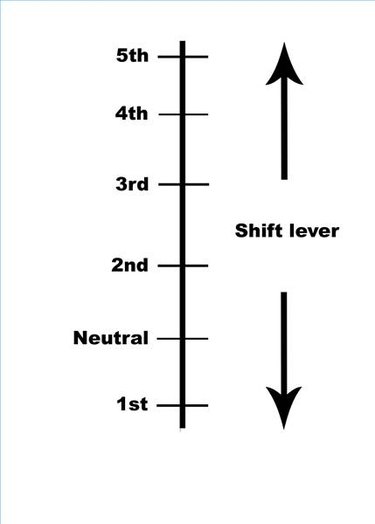Things You'll Need
Protective clothing
Helmet

Motorcycle riding is a refreshing and fulfilling sport that attracts people from all walks of life. Learning to ride a motorcycle with a manual transmission can be a challenge. One concept that some beginning riders find difficult is learning to change gears. Below is a step-by-step guide to changing gears that will get you ready to take to the open road as quickly as possible. As with many things, practice improves performance.
Orientation:
The shift lever is located on the left side when astride the motorcycle. It is operated by your left toe. The heel of your foot will rest on a larger peg while the toe of your foot is used to lift up or push down on the shift lever to change gears. The clutch lever is located on the left steering handlebar. You will squeeze the clutch lever to disengage the gearbox and allow smooth transition from one gear to the next. As seen in the picture, from the neutral position, push down on the shift lever to select first gear, then lift up for all sequential gears thereafter. There are generally five gears and a neutral setting, though some bikes have a sixth.
Step 1
Start the motorcycle, squeeze the clutch lever then push down on the shift lever with your left toe to put it in first gear. To get a feel for how sensitive the clutch is, slowly add the throttle and begin releasing the clutch lever until you feel it begin to engage, then re-squeeze the clutch lever and release the throttle. Do this several times until you are familiar with where in the clutch release it begins to engage and how much throttle is necessary to keep it from lugging and killing the engine.
Step 2
Begin riding by putting the motorcycle in first gear. Slowly release the clutch lever while adding throttle. Once you release the clutch lever all the way, increase the throttle to add speed. To learn how to change gears, refer to your tachometer and operator's manual and listen closely to the sound of the engine.
Step 3
Change gears by quickly squeezing the clutch lever while simultaneously releasing the throttle. Pivot your foot and lift up firmly on the gear selector with your left toe to change to second gear. Quickly and smoothly release the clutch lever and add throttle. Take caution not to add too much throttle, as this will cause the motorcycle to lunge forward, while too little throttle will cause the motorcycle to slow down and cause you to shift your body forward. Avoid releasing the clutch too slowly. Allowing the clutch to engage only partially is called, "slipping the clutch," and this will cause excessive heat and premature wear to the clutch. Continue the same shifting process through the rest of the gears as needed for the speed you wish to go.
Step 4
Slow down using one of the following two methods: 1) Squeeze the clutch lever and apply the brakes; 2) Downshift by squeezing the clutch lever, releasing the throttle and pressing down on the shift lever to select a lower gear, then slowly release the clutch and apply throttle as needed. The engine will serve as a brake in this method.
Step 5
Place the motorcycle back into neutral using one of the following two methods: 1) When downshifting from second gear, gently press down on the shift lever to place the gearbox in neutral. If you push down too hard, it may go into first gear; 2) Put the motorcycle in first gear, then gently lift up on the shift lever to enter neutral. If you lift too hard, it may enter second gear. On some motorcycles, there is a light on the instrument cluster indicating when you are in neutral; otherwise slightly release the clutch to confirm whether or not you are in neutral.